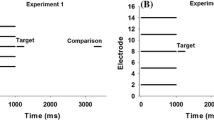Abstract
The loudness of a tone can be reduced by preceding it with a more intense tone. This effect, known as induced loudness reduction (ILR), has been reported to last for several seconds. The underlying neural mechanisms are unknown. One possible contributor to the effect involves changes in cochlear gain via the medial olivocochlear (MOC) efferents. Since cochlear implants (CIs) bypass the cochlea, investigating whether and how CI users experience ILR should help provide a better understanding of the underlying mechanisms. In the present study, ILR was examined in both normal-hearing listeners and CI users by examining the effects of an intense precursor (50 or 500 ms) on the loudness of a 50-ms target, as judged by comparing it to a spectrally remote 50-ms comparison sound. The interstimulus interval (ISI) between the precursor and the target was varied between 10 and 1000 ms to estimate the time course of ILR. In general, the patterns of results from the CI users were similar to those found in the normal-hearing listeners. However, in the short-precursor short-ISI condition, an enhancement in the loudness of target was observed in CI subjects that was not present in the normal-hearing listeners, consistent with the effects of an additional attenuation present in the normal-hearing listeners but not in the CI users. The results suggest that the MOC may play a role but that it is not the only source of these loudness context effects.




Similar content being viewed by others
References
Arieh Y, Marks LE (2003) Time course of loudness recalibration: implications for loudness enhancement. J Acoust Soc Am 114:1550–1556
Cooper NP, Guinan JJ Jr (2003) Separate mechanical processes underlie fast and slow effects of medial olivocochlear efferent activity. J Physiol 548:307–312
Elmasian R, Galambos R (1975) Loudness enhancement: monaural, binaural, and dichotic. J Acoust Soc Am 58:229–234
Elmasian R, Galambos R, Bernheim A Jr (1980) Loudness enhancement and decrement in four paradigms. J Acoust Soc Am 67:601–607
Goupell MJ, Mostardi MJ (2012) Evidence of the enhancement effect in electrical stimulation via electrode matching. J Acoust Soc Am 131:1007–1010
Guinan JJ Jr (2006) Olivocochlear efferents: anatomy, physiology, function, and the measurement of efferent effects in humans. Ear Hear 27:589–607
ISO:226 (2003) Acoustics—normal equal-loudness-level contours. International Organization for Standardization. Geneva, Switzerland
Jacobson M, Kim S, Romney J, Zhu X, Frisina RD (2003) Contralateral suppression of distortion-product otoacoustic emissions declines with age: a comparison of findings in CBA mice with human listeners. The Laryngoscope 113:1707–1713
Jesteadt W (1980) An adaptive procedure for subjective judgments. Percept Psychophys 28:85–88
Keppel G, Wickens TD (2004) Design and analysis: a researcher’s handbook. Pearson Prentice Hall, Upper Saddle River, NJ
Kim S, Frisina DR, Frisina RD (2002) Effects of age on contralateral suppression of distortion product otoacoustic emissions in human listeners with normal hearing. Audiol Neurotol 7:348–357
Liberman MC (1988) Response properties of cochlear efferent neurons: monaural vs. binaural stimulation and the effects of noise. J Neurophysiol 60:1779–1798
Mapes-Riordan D, Yost WA (1999) Loudness recalibration as a function of level. The Journal of the Acoustical Society of America 106:3506–3511
Marks LE (1994) “Recalibrating” the auditory system: the perception of loudness. J Exp Psychol Hum Percept Perform 20:382–396
Nieder B, Buus S, Florentine M, Scharf B (2003) Interactions between test- and inducer-tone durations in induced loudness reduction. J Acoust Soc Am 114:2846–2855
Oberfeld D (2007) Loudness changes induced by a proximal sound: loudness enhancement, loudness recalibration, or both? J Acoust Soc Am 121:2137–2148
Oberfeld D (2008) The mid-difference hump in forward-masked intensity discrimination. J Acoust Soc Am 123:1571–1581
Pickles JO (2013) An introduction to the physiology of hearing, 4th edn. Brill, Leiden
Plack CJ (1996) Loudness enhancement and intensity discrimination under forward and backward masking. J Acoust Soc Am 100:1024–1030
Scharf B, Buus S, Nieder B (2002) Loudness enhancement: induced loudness reduction in disguise? (L). J Acoust Soc Am 112:807–810
Stankovic KM, Guinan JJ Jr (1999) Medial efferent effects on auditory-nerve responses to tail-frequency tones. I. Rate reduction. J Acoust Soc Am 106:857–869
Wang N, Kreft H, Oxenham AJ (2012) Vowel enhancement effects in cochlear-implant users. J Acoust Soc Am 131:EL421–426
Wang N, Kreft HA, Oxenham AJ (2015) Loudness context effects in normal-hearing listeners and cochlear-implant users. J Assoc Res Otolaryngol 16:535–545
Zeng FG (2004) Trends in cochlear implants. Trends Amplif 8:1–34
Zwislocki JJ, Sokolich WG (1974) On loudness enhancement of a tone burst by a preceding tone burst. Percept Psychophys 16:87–90
Acknowledgments
This work was supported in part by NIH grant R01 DC012262. Author NW was supported by Advanced Bionics and by a Dissertation Fellowship from the Graduate School of the University of Minnesota.
Author information
Authors and Affiliations
Corresponding author
Rights and permissions
About this article
Cite this article
Wang, N., Kreft, H. & Oxenham, A.J. Induced Loudness Reduction and Enhancement in Acoustic and Electric Hearing. JARO 17, 383–391 (2016). https://doi.org/10.1007/s10162-016-0563-y
Received:
Accepted:
Published:
Issue Date:
DOI: https://doi.org/10.1007/s10162-016-0563-y




